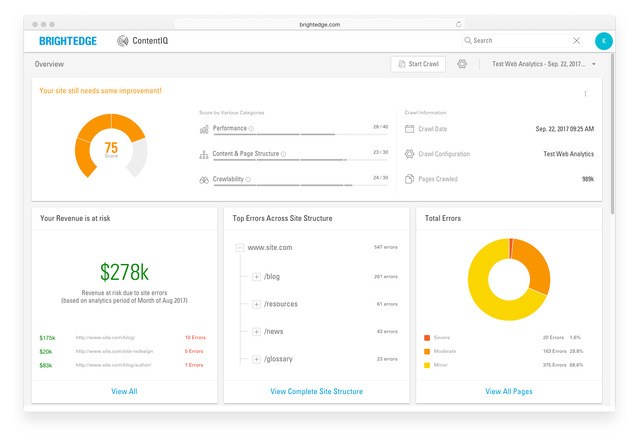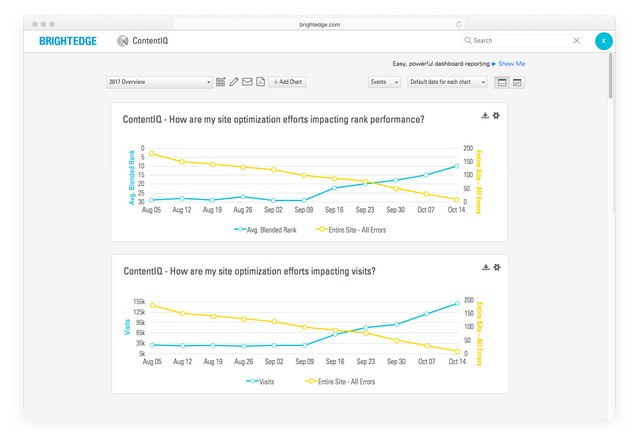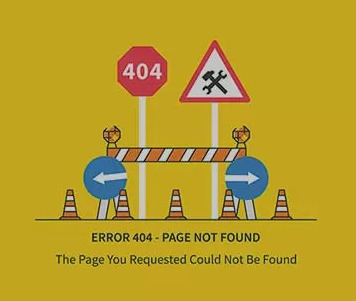Your boss brings in cupcakes on Friday afternoon to celebrate a good quarter of hitting revenue goals… That’s a good surprise. Your boss phoning you at midnight to find why site traffic has suddenly dropped 20%... That’s a bad surprise. The last thing any digital marketer wants is unexpected drops in website key performance indicators (KPIs), particularly when they affect business revenue. These nasty surprises are typically the result of website errors, which are technical issues with your website that have an adverse effect on SEO performance. Site errors can happen at a site-wide level, such as NOINDEX tags that prevent search engines from indexing your content, page load times of more than three seconds, and 4xx errors, which usually mean broken links or blocked content. They also occur on individual pages, if you are missing page titles, H1 tags or meta descriptions, and if you have any duplicate content. Maintaining a healthy, surprise-free website means knowing about all your existing errors, understanding which fixes will have the biggest impact, and ensuring you can get the resources to implement the required changes. An SEO website audit is a critical first step in finding errors and site issues.
Identify and prioritize a website audit and errors with ContentIQ
BrightEdge ContentIQ is a next-generation site auditing solution that brings sanity to the process of reducing website errors that could impact SEO performance. It allows you to identify technical and on-page errors across your entire site, prioritize those errors with the severest impact on SEO performance and user  experience, build a business case for allocating resources to these key fixes and showcase your successes to the wider business and executives. ContentIQ works by inspecting your site, whether that’s a few key sections or the entire thing. Depending on the size of your site (ContentIQ can crawl hundreds of millions of pages) and its overall technical health, ContentIQ could highlight thousands of errors. Prioritizing which errors to fix is the key to delivering the biggest impacts up front. Showcasing these wins to the wider business can help you secure additional resources and fix more errors. To help you make the most from your website error resolution work, we’ve collected best practices and insights from BrightEdge users like you as well as our own crack team of SEO experts. The result is a simple five-step process for improving your site and achieving measurable success.
experience, build a business case for allocating resources to these key fixes and showcase your successes to the wider business and executives. ContentIQ works by inspecting your site, whether that’s a few key sections or the entire thing. Depending on the size of your site (ContentIQ can crawl hundreds of millions of pages) and its overall technical health, ContentIQ could highlight thousands of errors. Prioritizing which errors to fix is the key to delivering the biggest impacts up front. Showcasing these wins to the wider business can help you secure additional resources and fix more errors. To help you make the most from your website error resolution work, we’ve collected best practices and insights from BrightEdge users like you as well as our own crack team of SEO experts. The result is a simple five-step process for improving your site and achieving measurable success.
- Establish a baseline
- Fix site-wide performance issues
- Prioritize site errors based on the business impact
- Communicate your successes
1. Establish a baseline. Before you start fixing errors, it’s important to know where you are. Creating a baseline picture of the current health of your site at the beginning of the process will help you understand exactly which fixes worked best. You can also see how to deliver even better results and tell the story of where your efforts boosted KPIs. First, set up ContentIQ to perform a weekly or monthly crawl of your entire site to create a complete picture. Next, use our reporting product, StoryBuilder, to create a baseline dashboard of charts showing how site errors have impacted website KPIs, using your preferred metrics like traffic, revenue, or conversions correlated to the site errors across your entire domain. A major benefit when you establish your baseline is you can now track any critical deviations using our Anomaly Detection feature. For example, if one of your key revenue-driving pages needs to appear in the top three of search results for optimal performance, you can use Anomaly Detection to alert you by email when it drops position. This ensures you’re all over any potential problems and can resolve them before the impact is too severe. This will allow you time to find the source of the problem and fix it, without having to worry about being caught off guard by frantic phone calls after hours.

2. Fix site-wide performance issues. With your baseline in place, you’re ready to start fixing errors and seeing positive results. We’ve learned that focusing first on errors that affect your site as a whole is a fast-track to quick and easy wins. These are the kind of errors that prevent people from finding your site in searches or getting a “page not found” or other error when they do click your link. Some examples of errors that you will want to prioritize and correct during this stage are:
-
No index errors
-
Nofollow errors
-
HTTP Status (4xx errors)
-
Slow page load times (above 3 seconds)
3 and 4. Prioritize site errors based on the business impact. ContentIQ integrates with your Google Analytics account, making it easy to see which pages have the greatest impact on your site’s revenue, traffic, or conversions. If ContentIQ reveals errors on these money-making pages, you’ll know that you should prioritize these pages to fix first. In the case of multiple on-page errors, we recommend prioritizing the most severe errors, including:
-
Missing or empty page titles
-
Duplicate page content
-
Missing H1 tags
-
Missing or empty meta description tags
ContentIQ can help when you need to make the business case for more web development resources to fix these errors. Use your baseline dashboard to create charts showing how unresolved errors result in the decline of key site metrics, like revenue, conversion, or traffic, and clearly demonstrate the impact of poor user experience.
5. Communicate your successes. Nothing supports a business case more than proven success, so it’s important to track how your site’s performance improves as your reduce errors. The baseline dashboard you created in Step 1 will update automatically using data from the weekly or monthly ContentIQ crawls you scheduled. This makes it easy to review and chart your progress at regular intervals. When you complete a batch of significant improvements, such as rectifying issues with 4xx errors, it’s easy to create an event tag for that day so you can see how those efforts correlate to traffic and revenue growth. With StoryBuilder, you can create easy-to-understand charts for your executive teams and wider business that showcase how your efforts directly impact business KPIs. This will not only help promote the good work you’re doing, it’ll also demonstrate the continued value of fixing existing site errors and prioritizing further site enhancements.

Following this simple five-step process will help you to reduce the number of critical errors on your website and have a positive impact on your business’s results. ContentIQ puts all the information about your site’s page in one place, saving time and providing a more focused and productive approach to fixing site errors and improving SEO performance. Download the ContentIQ Datasheet to learn more about ContentIQ.


